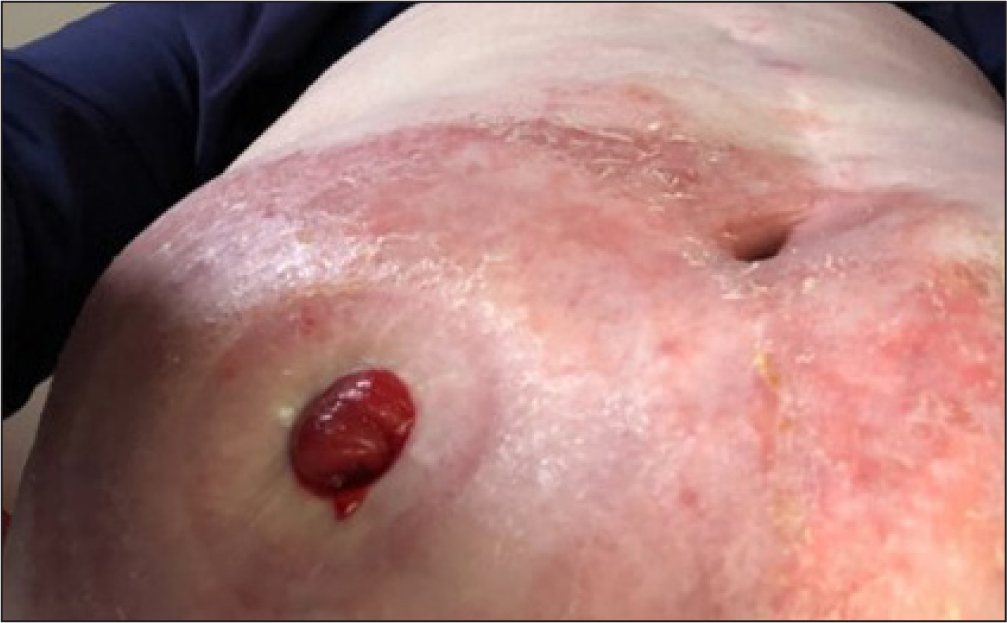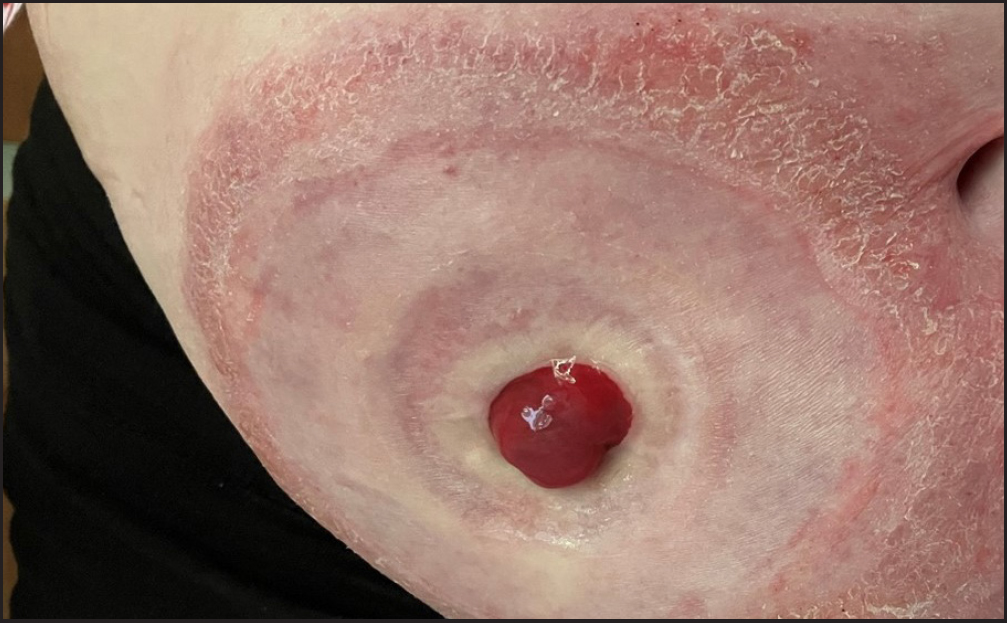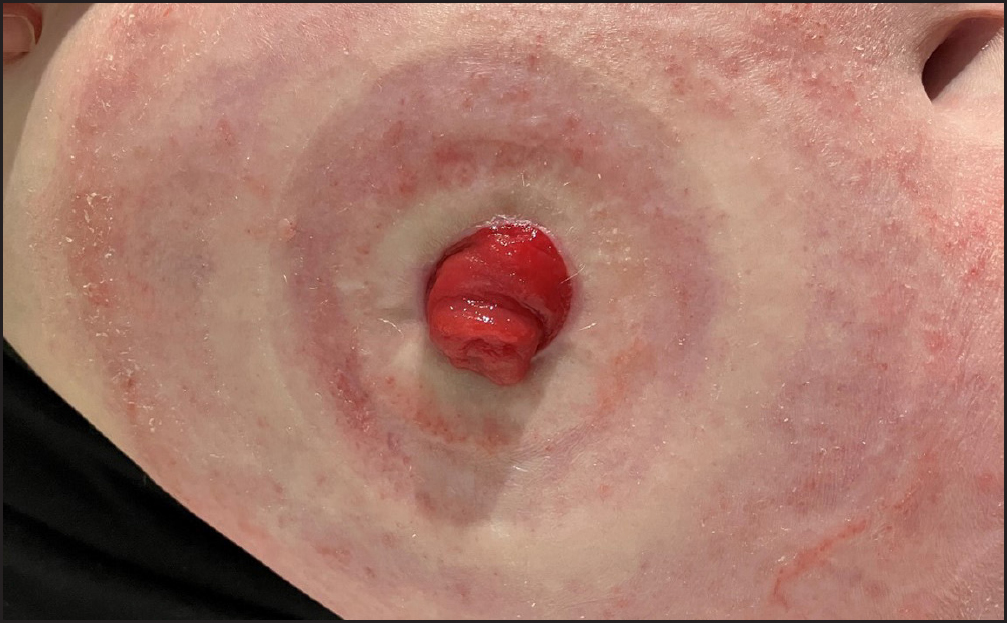It is well documented that a well-sited stoma can reduce the risk of complications such as leakage, which can lead to skin damage (Le Ber, 2021). This has been confirmed by Kim et al (2021), who found that preoperative stoma siting reduced the incidence of stoma complications by 53%. It also makes stoma care management less complicated as some skin creases/folds can be avoided, and the stoma can be sited away from potential wound/drain sites or other areas known to be problematic for stoma management. Kim et al (2021) also highlighted that a well-sited stoma can increase independence with stoma care.
Management of stoma-related complications, such as leakage and peristomal skin problems, accounts for a substantial burden on the healthcare system (Kugler et al, 2021). It is therefore essential that the stoma care clinical nurse specialist (CNS) makes informed clinical decisions to optimise the care given to this patient group so they can achieve the best outcome regarding quality of life as well as to ensure the patient pathway provides value-based procurement.
With increasing demand for healthcare and limited financial resources, there are ongoing challenges to deliver care at the required level. Value-based procurement moves the emphasis from product costs to considering a patient pathway as this can lead to a reduction in total costs (NHS Supply Chain, 2024). This approach should also deliver tangible, measurable benefits that make a positive impact on patient care as well as increase efficiency.
Boyles and Hunt (2016) suggested that while ‘many patients will have to deal with problematic skin at some point, it should not be considered the acceptable norm as it can have profound impact on an individual's optimal physical, psychological and social functioning’. Improving the quality and safety of healthcare is a system-wide priority. At times when the NHS is under substantial financial pressures to deliver efficiency savings, Getting It Right First Time (GIRFT) has never been more important (White and Evans, 2019). GIRFT is an NHS England initiative designed to improve the treatment and care of patients by clinicians through an in-depth review of services to support change (NHS England, 2024).
It is essential that people with a stoma have confidence in their appliance and are able to continue their usual lifestyle without the fear of leakage or damage to peristomal skin. Recent advances in stoma care include adhesive flanges permeated with skin-friendly ingredients such as manuka honey, aloe vera, ceramide and vitamin E (Sica, 2018), and stoma care technology has resulted in appliances that are more secure and skin friendly, have the ability to control moisture and can be worn for longer (Lager and Loxdale, 2021).
The Nursing and Midwifery Council (2018) code states that nurses must ‘always practise in line with the best available evidence and make sure that any information or advice given is evidence-based including information relating to using any health and care products or services’.
Keeping up to date with best practice as part of the stoma care CNS role includes meeting company representatives to ensure these practitioners have a good knowledge base around the range of appliances and products that can be used with their patients. Alongside their extensive clinical knowledge and experience, doing this means the stoma care CNS is often able to rectify any issues a person may be having with their stoma by referring to their knowledge of products available to find a suitable solution.
Often a pouch with a flange additive is selected for a patient with peristomal skin damage because the nurse has knowledge of these devices and has used them previously with success. However, when focusing on value-based procurement and GIRFT, the question has to be asked whether the stoma care CNS should be more proactive in their approach and use such a product before the patient starts experiencing problems rather than waiting until an issue arises (there are no tools available that can be used to predict skin or stoma problems). This approach could improve patient outcomes and increase or maintain patient quality of life, as well as reduce the cost of stoma care.
Case study: preventing leaks and treating peristomal skin damage
Mrs Green was diagnosed with transverse myelitis in 2015 which resulted in the formation of a colostomy and a urostomy. Transverse myelitis is a rare neurological disorder that occurs when the spinal cord become inflamed, damaging the myelin sheath that protects nerve cells. This can cause pain, muscle weakness, paralysis and bladder and/or bowel problems.
Mrs Green was experiencing complications with her urostomy when she was referred to a community stoma care CNS. She had gone several years without seeking help because of a fear of hospitals so was delighted to be offered a stoma care review at her home.
Following initial review, the main challenges identified were frequent leaks and skin breakdown. This had been ongoing for several years, resulting in skin infections requiring treatment with oral antibiotics and steroid preparations. During the initial examination, the skin was found to be red, broken, weeping and itchy (Figure 1). Using the validated Ostomy Skin Tool (Coloplast, 2016), a DET (discolouration, erosion and tissue overgrowth) score of 9 was reported, which indicated severe skin damage.

It was evident that the problems were a result of mechanical trauma. The appliance adhesive was pulling the skin, causing the skin to tear and become painful. The skin would then ooze and become infected, causing the pouches to leak and subsequently fall away from the skin. This resulted in soiled clothing and bedding, causing anxiety and reducing Mrs Green's quality of life. Mrs Green was also having to change her pouch 2–3 times a day and required additional accessories to manage her urostomy.
Mrs Green's urostomy sits in a dip and retracts at times, causing very frequent leakage. This is often a challenging situation and can be resolved by using a convex appliance (McNichol et al, 2021).
During the initial review, Mrs Green described the impact of these difficulties on her life. She mentioned that her son was getting married and she was feeling particularly anxious about attending the wedding and staying overnight in the hotel. The fear of the stoma appliance leaking and any associated perceived embarrassment meant she did not have the confidence to attend the wedding. She had previously enjoyed holidays and socialising; however, this had not been possible for her over the past few years because of leaks from her stoma appliance.
Mrs Green had already evaluated the Aura Plus Soft Convex closed pouch for her colostomy, with favourable outcomes and feedback. The Aura Plus Soft Convex device was identified as a suitable option for her urostomy and she was keen to try it. It was determined that the softness and shape of the flange would allow greater flexibility and cause less friction to the skin. A discussion around the differences in the pouch took place, and Mrs Green was given a demonstration of how to use it. She was informed of the reasons for choosing this appliance; the gentle support of the soft convex pouch could help the stoma protrude into the pouch while improving adherence and the medical-grade manuka honey (an integral part of the flange) might help to improve the condition of the skin around the stoma (White and Evans, 2019).
Because of the wetness of the skin and the poor adhesion of Mrs Green's usual pouches, stoma powder and a barrier preparation were used to help the skin dry and heal (O'Flynn, 2019). She usually used barrier wipes, but a barrier spray was recommended for a more consistent and even coverage. She was also advised to use an adhesive remover to minimise the risk of further trauma to the skin (Rudoni, 2008).
Mrs Green had a follow-up via email after 1 week; this was her preferred method of communication. She confirmed that the pouches were no longer leaking and that she was achieving a minimum of 24 hours wear time, compared to having to change her pouch two or three times a day. She reported improvements in the condition of her peristomal skin, explaining that it was in the best condition she has seen it for a considerable period of time. In addition, she mentioned she was already feeling much more confident and was looking forward to attending her son's wedding without the fear of stoma pouch leakage.
Mrs Green had a face-to-face visit after 2 weeks. It was acknowledged that the skin underneath the flange area had healed significantly, and that the skin surrounding the pouch was starting to show signs of improvement (Figure 2). The skin problems had been ongoing for several years, so Mrs Green was aware that this area might not heal as quickly but was very pleased with the progress nonetheless. She reported being able to sleep flat (she had had to sleep sitting before), something that she had not been able to do for years, which had significantly impacted her sleep. Mrs Green remained leak free both day and night, her skin was less itchy and she was very happy with the progress made.

A third home visit was conducted after 6 weeks. Mrs Green had continued to show exceptional progress, reporting no leaks with the Aura Plus Soft Convex device, which resulted in improved sleep. Her peristomal skin had continued to heal well. She was given a sample of a barrier cream to help protect, moisturise and heal the areas of skin where there were signs of irritation, which happened to be the area of skin not covered by the adhesive flange with medical-grade manuka honey.
At a 10-week visit, Mrs Green appeared much brighter and looked physically well. On observation, her peristomal skin had improved significantly (Figure 3). Antibiotics and steroids have not been required since the change to Aura Plus Soft Convex. She was advised to continue to use the barrier cream until the scaly skin beyond the flange area was fully healed.

Mrs Green is now again able to get out and about more, saying: ‘You can't keep me in!’ She enjoys walking her dog and socialising with friends, is sleeping well and continuing to be leak free both day and night.
Conclusion
It is evident that this patient benefited from not only the incorporation of a convex flange but also the addition of manuka honey to the flange.
As she had previously evaluated and continued to use a similar baseplate for her colostomy pouch and noted the benefits of manuka honey to her skin, there is evidence to suggest that the nurse could have been more proactive in helping to prevent skin issues before they arose when using clinical judgment in selecting the right pouch for their patient. This would also fit well into GIRFT and the NHS value-based procurement pathway as it would have delivered tangible, measurable benefits that have a positive impact on patient care as well as increasing efficiency in terms of both finance and time.


